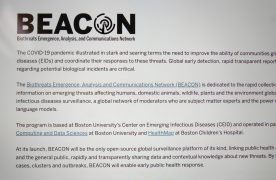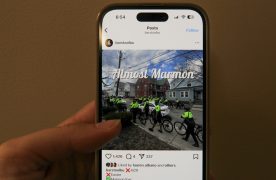By Eddie Donga, Daily Free Press staff writer
I was surprised to find BU’s National Emerging Infectious Disease Laboratories hidden in plain sight at 620A Albany St. in Roxbury, mostly because I had been searching for the inconspicuous building for almost 15 minutes.
Before entering the building for my tour with Interim Director Dr. John Murphy and Associate Director Richard Corley, I had to pass through security, where my belongings were x-rayed while I passed through a metal detector.
Apparently, I checked out because I was spared from having to pass through the explosives detector, but my cellphone and audio recorder were confiscated before one of the security guards on duty stared into an iris scanner (that scans the iris of the eye to verify one’s identity) that unlocked the entrance to the facility.
Murphy and Corey gave a brief lecture on the controversial new facility before beginning the tour of the Biosafety Level-2, Level-3 and Level-4 labs.
In order to operate the elevator to get to the lab floors, researchers must use a swipe card in the elevator proving they have clearance to be there, and then must pass an additional iris scanner to get into the actual labs.
The BSL-3 and BSL-4 facilities are still waiting for approval from the Massachusetts government before they can be used, but if approval is granted, they will house some of the most lethal pathogens in the world.
The BSL-4 will house the worst of the worst, such as Ebola virus and the plague, and therefore has the strictest safety features.
The lab is essentially a building within a building wrapped in 12 in. walls, a 14 in. ceiling and 16 in. floor of airtight concrete.
Researchers working in the BSL-4 must wear $2,600, airtight, positive pressure suits, which are made by the same company that makes actual space suits. These suits supply researchers with clean air while in the lab and prevent exposure to the lethal pathogens.
However, researchers are responsible for the maintenance of their own suits. Many fix small tears in the expensive high-tech suits with a more economic, low-tech solution: duct tape, said Associate Director, Dr. Richard Corley.
[slideshow]
All photos by Rachael Person, Daily Free Press staff photographer
This is an account occasionally used by the Daily Free Press editors to post archived posts from previous iterations of the site or otherwise for special circumstance publications. See authorship info on the byline at the top of the page.













This article contains disturbing similarities to a November 12th Stanford University press release. Note that the image caption is lifted directly from the article (with a few typos and grammatical flubs thrown in for good measure). I leave finding the remaining errors and violations as an excercise for the editorial staff.